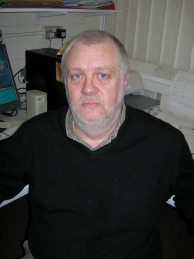|
Qualifications Ph.D. in Plant Sciences (Leeds, Feb 1979); BSc Hons. Biochemistry (Leeds, June 1975) Employment: Reader in Biotechnology, University of Leeds (2006 - continuing) Senior Lecturer in Biochemistry, University of Leeds (1993 – 2006) Lecturer in Biochemistry, University of Leeds (1986 – 1993) Postdoctoral Fellow, Imperial College (1981-1986) Postdoctoral Fellow, Purdue University, USA (1979-1981) Career to date Since gaining my PhD in 1979, my career has covered sequentially two distinct fields, plant science initially, and within the last 8-10 years, biotechnology centred on biosensors and biocatalysis. My postdoctoral work was initially within bioenergetics/protein chemistry of electron transfer and proton transport in photosynthetic membranes. During my second postdoctoral period I worked on control of membrane viscosity in photosynthetic membranes and the redox mediated protein kinase regulation of light harvesting. This involved gaining theoretical and biophysical expertise, particularly in steady state and micro/nanosecond domain time resolved spectroscopic techniques. Following the move to Leeds to take up a lectureship, I concentrated on the more regulatory aspects of photosynthesis and plant cell signalling, gaining substantial funding for work on plant cell GTP binding proteins and also to investigate the signalling pathways triggered by binding of the phytohormone auxin. As a necessary part of this I developed expertise in synthesis of peptide and their use as synthetic antigens and also in various aspects of plant molecular biology, including the preparation of transgenic plants. Overall the plant science phase of my career has resulted in around 60 papers, the majority in peer reviewed journals. Around 8 to 10 years ago, however, my interest in plant science started to wane and I started to collaborate with a colleagues in work on protein stabilisation and biosensors, and on other topic such as the biology/biochemistry of waste water treatment. The wider than normal training undertaken has proved useful in interacting with consortia of researchers in very disparate disciplines, to solve biotechnological problems. Initial successes in attracting funding from a range of sources was for work on biosensors directed toward the detection on organophosphate pesticide in foodstuffs and water in the environment. In addition to developing novel affinity strategies for the tethering of the sensing enzyme, we also determined the means of stabilising the completed sensors during storage for more than 18 months. Following on from this, EC sponsored projects have been aimed at the development of a novel and generic immunosensor platform (project ELISHA), i.e. using antibodies as the biorecognition element, and in developing nanoparticulate enzyme catalysts based on biosilicates (Project SANTS) and other polymers (Project COMBIO). I am coordinator of both ELISHA and SANTS and my research team is now internationally recognised has having specific expertise in the immobilisation of enzymes and affinity proteins for both biosensor and biocatalytic applications, in essence the nanoscale design, construction and characterisation of such surfaces. Overall, funding for these activities of around £1.95M has been awarded to my group over the past 5 years. Long term aspirations Although the nature of my work is applied, I would like to provide a deeper background knowledge to underlie the development of affinity biosensors; presently the bulk electrochemistry is well known but there is little understanding at the scale of the individual molecule. Progress here should enable further development of electrochemical methodology for biochemical and molecular biological applications. I would also like to see commercialisation of the biosensors and biocatalysts we continue to develop. This would make for drastically shorter/cheaper analysis time or more specific chemical synthesis and enable respectively on site or ‘point of care’ analyte analysis, and environmentally sympathetic chemistry. To move towards these aspirations, a key philosophy within my group is effective nanoscale design to achieve the simplest biosensor/biocatalyst construction with systems completely self assembling if possible. Watch Dr. Millner giving an overview of Biosensor and Biocatalisys group |



